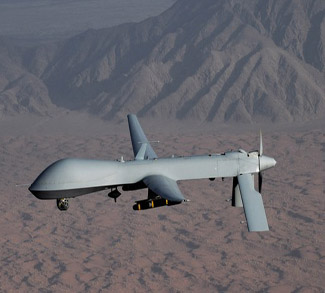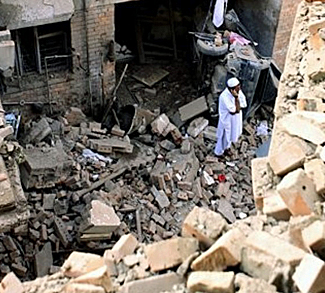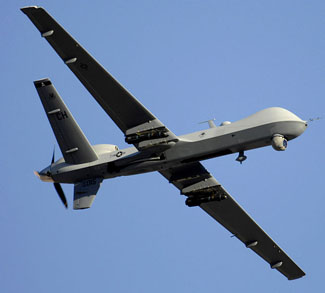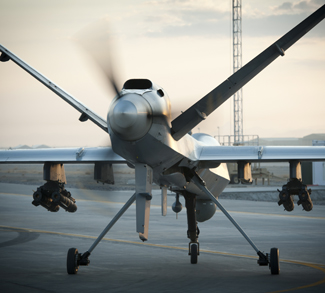Last week, a UN investigator called on the Obama administration to provide legal justification for its ever-expanding drone war in Yemen, Somalia, and Pakistan. Of course, no such justification was forthcoming, and the UN shouldn’t hold its breath for one given the fact that unmanned drone strikes are widely supported across the American electorate and carry very little direct political risk. But beyond the high profile targets that have been successfully assassinated, there is a more abstract indirect risk involved; one that threatens to drag out the long war that birthed the drone program in the first place.
If we were to take a step back and observe the drone program from every possible angle with perfect objectivity and full knowledge, we could be absolutely positive of one thing: the results of our study wouldn’t matter. Unmanned drone attacks are simply too popular, too effective, and too easy for any American president to drastically scale them back. To do so would certainly imperil his position by opening him up to charges of being an overly-judicial softy who isn’t committed to keeping the country safe. Thus it should come as no surprise that the United States government is planning to expand its fleet of unmanned drones by around 30 percent over the next ten years. And given the fact that active soldiers will be scaled back from 570,000 to 490,000 over the same period, it seems that unmanned drones will be occupying an important position in US national defense strategy over the short to medium term.
Although the debate over transnational drone strikes touches down on critical morale and legal issues, this article focuses solely on the question of whether or not they are effective from a strategic standpoint. This in itself is particularly important, because voting populations have proven themselves willing to shelve questions of morality in exchange for strategic efficacy and thus safety.
In terms of strategic repercussions, there are two questions that must be asked: just how many civilians are killed in the course of unmanned drone strikes and how do these deaths impact the wax and wane of global terrorism?
While the first question is the far more quantifiable of the two, a straightforward answer remains elusive. Everything from semantic tricks over what constitutes a ‘civilian’ to the often-impossible feat of discerning which smouldering body parts belonged to a terrorist makes the process of quantifying this kind of collateral damage an imprecise science. As such, several third party institutions have come up with their own methodology to count civilian deaths, but these results tend to vary wildly. The Long War Journal puts the civilian death count from drone strikes in Pakistan at 138, The New America Foundation estimates anywhere between 293 and 471, and the Bureau of Investigative Journalism (which employs independent researchers in Pakistan) puts the number at anywhere between 482 and 832.
The second question pertains to the impact that these deaths have on US national security, and the answer ranges from ‘negligible’ to ‘dramatic’ depending on the country in question.
Take Yemen for example, the target of President Obama’s recent authorization for expanded drone strikes, including ‘signature’ strikes that can be executed without knowing the name of the targeted militant. The local Al Qaeda branch, Al Qaeda in the Arabian Peninsula (AQAP) until recently drew most of its support from Yemenis who were fed up with the misrule that characterized former President Saleh’s 22 year tenure. For an exceedingly brief moment of time following Saleh’s resignation, it seemed like AQAP might be relegated to the same dustbin of history that the group’s abortive underwear bombers ended up in. But in fact the opposite has occurred. AQAP has been granted a new lease on life owing to a groundswell of anti-American sentiment sweeping through parts of Yemen, a phenomenon that is doubtlessly fueled by increasing drone strikes in the Abya and Shabwah provinces. Robert Grenier, a former leader of the CIA’s counter-terrorism unit, recently wrote a piece for Al-Jazeera in which he voiced his opinion that drone strikes have been taking militant groups with strictly local agendas and turning them into dedicated anti-Western crusaders who would be much more willing to rally under the flag of AQAP. He even went so far as to say that the current US policy risked turning Yemen into the “Arabian equivalent of Waziristan.” Elsewhere, Ahmad Khulani, the head of a Yemeni government committee on refugees, has said that up to 40,000 people have fled their homes in Abyan province alone out of fear of drone strikes. This also no doubt has served to further swell the ranks of AQAP.
And then there’s Pakistan, home to that aforementioned lawless territory which has now become shorthand for worst case scenario Islamic fundamentalist breeding ground. There is, of course, a compelling strategic rationale to continued strikes in Pakistan insofar that Pakistani security forces have in the past proven at best incapable at worst complicit in the fight against militants hiding within Pakistan’s tribal territories. Yet the very same drone strikes that continue to occasionally net high value targets are contributing to the political destabilization of Pakistan, which in turn creates severe risk towards a litany of American security interests given the country’s size, location, and nuclear status.
The Pakistani government thus finds itself in an impossible position. It cannot publically support the strikes, as to do so would be putting a stamp of approval on a foreign power killing innocent Pakistani citizens (between 138 and 832, depending on who you ask) with impunity. On the other hand, the threat posed by Islamic fundamentalism is a very real one to Pakistan’s nominally secular and democratic government, and violence has increasingly been spilling down from the tribal hinterland into major cities such as Peshawar and Lahore. This discord over drone strikes, particularly the complete absence of any face-saving option for the Pakistani government, has driven US-Pakistani relations to the brink.
When a militant is X’d off the US government ‘kill list,’ a list vetted by President Obama himself, another lower-level militant is bumped up or added to fill the space. Given the fact that being branded an enemy combatant in the War on Terror is a fluid, transnational, and seemingly never-ending process, it stands to reason that there will always be someone to add to the list; the pool of potential candidates will never be exhausted. Thus, we may get to the point when US drone strikes are more strategically damaging than they are useful. In fact, we may have already passed that point a long time ago.




